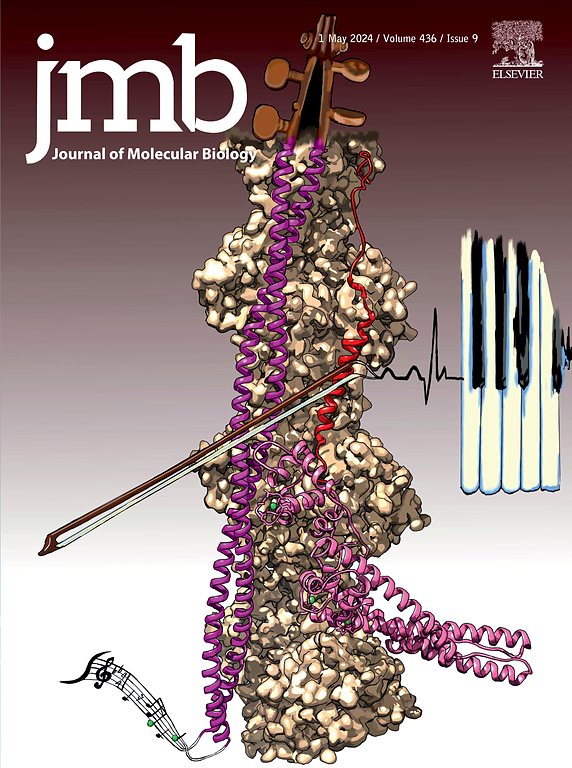Essential Roles of Conserved Pseudouridines in Helix 69 for Ribosome Dynamics in Translation
IF 4.7
2区 生物学
Q1 BIOCHEMISTRY & MOLECULAR BIOLOGY
引用次数: 0
Abstract
The widespread distribution of pseudouridine (Ψ), an isomer of the canonical uridine base, in RNA indicates its functional importance to the cell. In eukaryotes, it is estimated that around 2% of ribosomal RNA nucleotides are pseudouridines, most of which are located in functional regions of the ribosome. Defects in RNA pseudouridylation induce a range of detrimental effects from compromised cellular protein biosynthesis to disease phenotypes in humans. However, genome-wide changes to mRNA translation profiles by ribosomes lacking specific conserved pseudouridines have not been extensively studied. Here, using a new genomic method called 5PSeq and in vitro biochemistry, we investigated changes in ribosome dynamics and cellular translation profiles upon loss of Ψ2258 and Ψ2260 in helix 69, the two most conserved pseudouridines in the ribosome in yeast cells. We found that inhibiting the formation of these two pseudouridines challenges ribosomes to maintain the correct open reading frame and causes generally faster ribosome dynamics in translation. Furthermore, mutant ribosomes are more prone to pause while translating a subset of GC-rich codons, especially rare codons such as Arg (CGA) and Arg (CGG). These results demonstrate the presence of Ψ2258 and Ψ2260 contributes to the dynamics of the H69 RNA stem-loop, and helps to maintain functional interactions with the tRNAs as they move within the ribosome. The optimality of this ribosome-tRNA interaction is likely to be more critical for those limited tRNAs that decode rare codons. Consistent with the changes in ribosome dynamics, we observe that IRES-mediated translation is compromised in the mutant ribosome. These results explain the importance of Ψ2258 and Ψ2260 in H69 to maintain cellular fitness. The strong conservation of Ψ2258 and Ψ2260 in the ribosomes from bacteria to humans indicates their functional significance in modulating ribosome functions. It's likely that the identified functions of these covalent modifications are conserved across species.

螺旋69中保守假尿嘧啶在核糖体翻译动力学中的重要作用。
伪尿嘧啶(Ψ)是典型尿嘧啶碱基的异构体,在RNA中的广泛分布表明其对细胞的功能重要性。在真核生物中,估计约有2%的核糖体RNA核苷酸是假尿嘧啶,其中大多数位于核糖体的功能区域。RNA假尿嘧啶化缺陷诱导一系列有害影响,从细胞蛋白质生物合成受损到人类疾病表型。然而,缺乏特定保守假尿嘧啶的核糖体对mRNA翻译谱的全基因组变化尚未得到广泛研究。在这里,我们使用一种新的基因组学方法称为5PSeq和体外生物化学,研究了酵母细胞中核糖体中最保守的两个假尿嘧啶-螺旋69中Ψ2258和Ψ2260缺失时核糖体动力学和细胞翻译谱的变化。我们发现,抑制这两种假尿嘧啶的形成挑战了核糖体维持正确的开放阅读框,并导致核糖体在翻译过程中通常更快的动力学。此外,突变核糖体在翻译富含gc的密码子子集时更倾向于暂停,特别是罕见的密码子,如Arg (CGA)和Arg (CGG)。这些结果表明Ψ2258和Ψ2260的存在有助于H69 RNA茎环的动力学,并有助于维持与trna在核糖体内移动时的功能相互作用。这种核糖体- trna相互作用的最佳性可能对那些解码稀有密码子的有限trna更为关键。与核糖体动力学的变化一致,我们观察到ires介导的翻译在突变的核糖体中受到损害。这些结果解释了H69中Ψ2258和Ψ2260对维持细胞健康的重要性。从细菌到人类的核糖体中Ψ2258和Ψ2260的强保守性表明它们在调节核糖体功能方面的功能意义。我们预计这些共价修饰的鉴定功能在其他物种中是保守的。
本文章由计算机程序翻译,如有差异,请以英文原文为准。
求助全文
约1分钟内获得全文
求助全文
来源期刊

Journal of Molecular Biology
生物-生化与分子生物学
CiteScore
11.30
自引率
1.80%
发文量
412
审稿时长
28 days
期刊介绍:
Journal of Molecular Biology (JMB) provides high quality, comprehensive and broad coverage in all areas of molecular biology. The journal publishes original scientific research papers that provide mechanistic and functional insights and report a significant advance to the field. The journal encourages the submission of multidisciplinary studies that use complementary experimental and computational approaches to address challenging biological questions.
Research areas include but are not limited to: Biomolecular interactions, signaling networks, systems biology; Cell cycle, cell growth, cell differentiation; Cell death, autophagy; Cell signaling and regulation; Chemical biology; Computational biology, in combination with experimental studies; DNA replication, repair, and recombination; Development, regenerative biology, mechanistic and functional studies of stem cells; Epigenetics, chromatin structure and function; Gene expression; Membrane processes, cell surface proteins and cell-cell interactions; Methodological advances, both experimental and theoretical, including databases; Microbiology, virology, and interactions with the host or environment; Microbiota mechanistic and functional studies; Nuclear organization; Post-translational modifications, proteomics; Processing and function of biologically important macromolecules and complexes; Molecular basis of disease; RNA processing, structure and functions of non-coding RNAs, transcription; Sorting, spatiotemporal organization, trafficking; Structural biology; Synthetic biology; Translation, protein folding, chaperones, protein degradation and quality control.
 求助内容:
求助内容: 应助结果提醒方式:
应助结果提醒方式:


